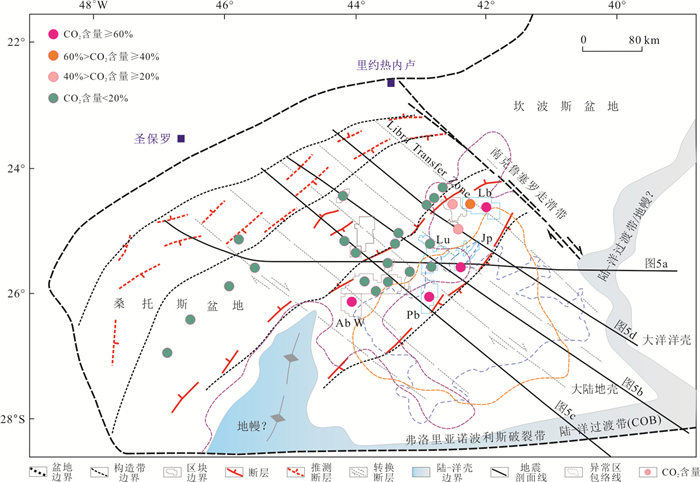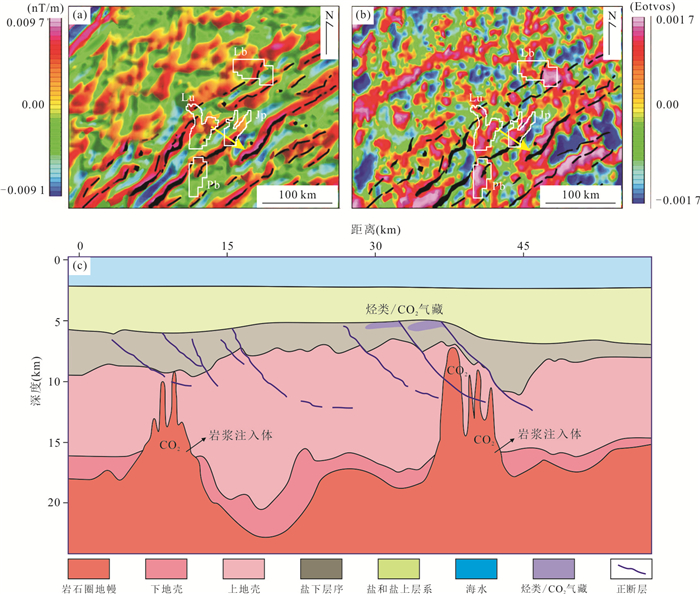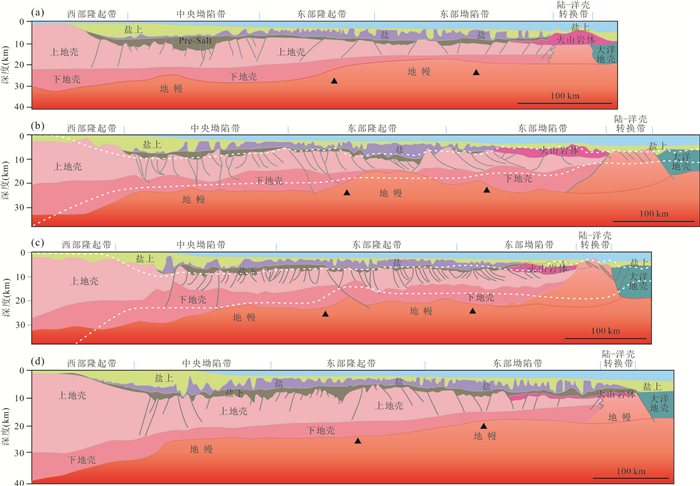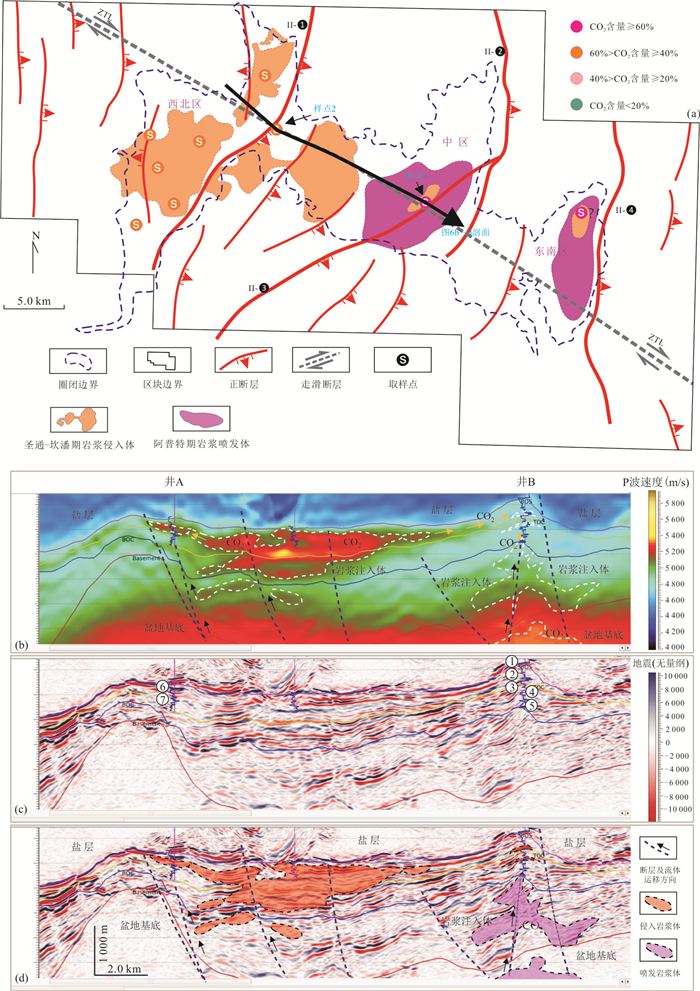Distribution and Main Controlling Factors of CO2 in Santos Basin, Brazil
-
摘要: 桑托斯盆地盐下油气田中发现了大量CO2,给油气勘探开发和生产都带来诸多困难和挑战.利用地层测试、样品分析及文献资料等,明确了CO2成因及来源,统计分析了其区域分布特征,并基于区域重磁和深源地震等资料,剖析了控制CO2分布的地质因素.盆内CO2主要为幔源—岩浆成因,且幔源CO2贡献了至少92%的CO2总量.区域上,CO2自陆向海呈增加趋势,并相对集中在盆地东部隆起带上.地壳减薄和地幔局部隆升是控制CO2宏观分布最重要的背景因素.极端的地壳伸展造成了圣保罗地台下部陆壳强烈拉伸减薄,形成了一个面积约5.1×104 km2的地壳减薄区,造成了富含CO2的地幔物质上拱进入陆壳,宏观上决定了盆内CO2区域分布.此区域之外,出现高含量CO2的可能性大幅降低.岩浆侵入和活动断层都是沟通隆升地幔和浅部储层的重要路径,但以断裂沟通最常见.NW-SE向区域走滑断裂和NE-SW向I-II级正断层对CO2在浅部地层中的分配起控制作用,两组断裂交汇部位或周缘是幔源岩浆或CO2最集中发育区.Abstract: An extraordinarily high amount of CO2found in pre-salt section in Santos basin poses great challenges to the oil and gas exploration and development. In this study, combining regional gravity and magnetic database, deep-seismic lines, well drilling, formation test and samples dataset of the basin, the origin of CO2 was clarified firstly, and its regional distribution patterns were statistically analyzed and their main controlling factors were explored as well. The widely distributed CO2 in pre-salt reservoirs in Santos basin is mainly sourced from mantle, and mantle-derived CO2 contributes at least 92% of the total volume of CO2. Regionally, CO2 abundance gradually increases from continent to ocean, and is relatively concentrated in the eastern uplift of the basin. On its margin usually occurs the current maximum CO2 content values. The extra-high CO2 abundance in Santos basin is the result of the combined action of various geological factors such as crust & mantle transition, regional tectonic evolution, magma events and fault activity. Among them, continental crust thinning and mantle uplifting are the most important background factors, controlling the regional distribution of CO2. The intensive extension of crust caused a strong stretching and thinning of the lower continental crust of Sao Paulo platform, forming a crustal thinning area, around 5.1×104 km2, which caused the CO2-rich mantle material to intrude upward into the continental crust. This uplifted mantle has directly controlled the regional distribution of CO2 in Santos basin. Outside this area, the risk of CO2 is significantly reduced. Magma injection or active faults are both important pathways for CO2 migration and accumulation, with most common cases involving active faults leading CO2 from "uplifted" mantle to shallower reservoirs. The NW-SE strike-slip faults and the NE-SW class I-II normal faults have an obvious control effect on distribution of CO2 in shallower formation: NW-SE strike-slip fault could extend into deep mantle, while the NE-SW normal faults distribute these CO2 in shallower layers. So that their intersection points or periphery areas are the most favorable areas for accumulation of magma and CO2.
-
图 1 桑托斯盆地构造单元划分及综合地层柱状简图
图a据Sandwell and Smith(2009)编绘; 走滑断裂体系据Cobbold et al.(2001)、Meisling et al.(2001)和Evain et al.(2015)编绘; 地层柱状图据Moreira et al.(2007)编绘
Fig. 1. Structural unit division and integrated stratum column of Santos basin
图 2 桑托斯盆地CO2同位素特征及幔源CO2含量估算
a. CO2成因判识图,据Dai et al.(1996);b.幔源CO2含量估算图,据Santos et al.(2012)
Fig. 2. Carbon isotope of CO2 and mantle derived CO2 content estimation
图 3 桑托斯盆地CO2分布及盆地深部地壳结构简图
区块分布据http://rodadas.anp.gov.br/arquivos/Bienio/Mapas_LP7-8/R7_R8_LP_GERAL.pdf
Fig. 3. Sketch map of CO2 distribution and deep crustal structure in Santos basin
图 4 Jp构造及周缘预测岩浆体与CO2分布对应关系
据Gamboa et al.(2019)改编;a. 磁力图一阶导数;b. 剩余布格重力图;c. 二维地质解释模型(位置见图a和b中黄色箭头)
Fig. 4. Distribution maps of predicted igneous rocks and CO2 around the Jp structure
图 5 桑托斯盆地深源地震剖面及深部壳幔结构剖面
剖面位置见图 3;图 5a和5d中二维地震剖面底图据Kumar et al.(2012)修编;图 5b和5c中San Ba地震剖面底图据Evain et al.(2015)修编,其中白色虚线为Zalán et al.(2011)解释出的基底构造和莫霍顶面
Fig. 5. Deep crustal structure profiles from deep-source seismic data in Santos basin
图 6 桑托斯盆地Lb区块断裂与CO2分布
区块位置见图 3;图a据Rancan et al.(2018)和Zhao et al.(2019);图b为地震速度剖面;图c和d为常规地震剖面,其中c未带解释方案剖面,d为带解释方案剖面;黄色箭头指CO2,黑色箭头为岩浆
Fig. 6. Distribution map of faults and CO2 in Lb block
表 1 Lb区块不同构造位置CO2含量及流体性质统计
Table 1. Statistic table of CO2 content and fluid properties in Lb block
样品位置 取样位置 样品类型 闪蒸气体中CO2(摩尔百分比) 原位地层中CO2(摩尔百分比) 气油比(m3/m3) 原油密度(°API) 样点1 ① 气 67.16 65.26 3 077.17 36.36 ② 气 67.55 65.37 2 834.43 37.67 ③ 气 67.58 65.51 2 954.30 37.25 ④ 气 67.32 65.31 2 958.99 37.01 ⑤ 气 66.95 64.88 2 931.61 37.57 样点2 ⑥ 油 43.40 37.29 436.13 27.28 ⑦ 油 43.37 37.25 438.64 27.15 注:取样位置见图 6c. -
Aslanian, D., Moulin, M., Olivet, J. L., et al., 2009. Brazilian and African Passive Margins of the Central Segment of the South Atlantic Ocean: Kinematic Constraints. Tectonophysics, 468(1-4): 98-112. https://doi.org/10.1016/j.tecto.2008.12.016 Ballentine, C. J., Burnard, P. G., 2002. Production, Release and Transport of Noble Gases in the Continental Crust. Reviews in Mineralogy and Geochemistry, 47(1): 481-538. https://doi.org/10.2138/rmg.2002.47.12 Clayton, C. J., 1995. Controls on the Carbon Isotope Ratios of CO2 in Oil and Gas Fields. 17th International Meeting on Organic Geochemistry, Donostia-San Sebastian. Cobbold, P. R., Meisling, K. E., Mount, V. S., 2001. Reactivation of an Obliquely Rifted Margin, Campos and Santos Basins, Southeastern Brazil. AAPG Bulletin, 85(11), 1925-1944. https://doi.org/10.1306/8626D0B3-173B-11D7-8645000102C1865D Dai, J. X., Song, Y., Dai, C. S., et al., 1996. Geochemistry and Accumulation of Carbon Dioxide Gases in China. AAPG Bulletin, 80(10): 1615-1626. https://doi.org/10.1306/64eda0d2-1724-11d7-8645000102c1865d Dehler, N. M., Magnavita, L. P., Gomes, L. C., et al., 2016. The 'Helmut' Geophysical Anomaly: A Regional Left-Lateral Transtensional Shear Zone System Connecting Santos and Campos Basins, Southeastern Brazil. Marine and Petroleum Geology, 72: 412-422. https://doi.org/10.1016/j.marpetgeo.2016.01.012 Dickson, W. G., Fryklund, R. E., Odegard, M. E., et al., 2003. Constraints for Plate Reconstruction Using Gravity Data-Implications for Source and Reservoir Distribution in Brazilian and West African Margin Basins. Marine and Petroleum Geology, 20(3-4): 309-322. https://doi.org/10.1016/S0264-8172(03)00039-4 Dickson, W., Schiefelbein, C., Zumberge, J., et al., 2005. Basin Analysis in Brazilian and West African Conjugates: Combining Disciplines to Deconstruct Petroleum Systems. Petroleum Systems of Divergent Continental Margin Basins: 25th Annual, Houston. https://doi.org/10.5724/gcs.05.25.0790 Dinh, N. V., 1997. Distribution and Origin of Carbon Dioxide in the Song Hong Basin of Offshore Vietnan. Proceedings of the International Conference on Petroleum Systems of SE Asia and Australasia, Jakarta. Evain, M., Afilhado, A., Rigoti, C., et al., 2015. Deep Structure of the Santos Basin-São Paulo Plateau System, SE Brazil. Journal of Geophysical Research: Solid Earth, 120(8): 5401-5431. https://doi.org/10.1002/2014jb011561 Gamboa, L., Ferraz, A., Baptista, R., et al., 2019. Geotectonic Controls on CO2 Formation and Distribution Processes in the Brazilian Pre-Salt Basins. Geosciences, 9(6): 252. https://doi.org/10.3390/geosciences9060252 Gilfillan, S. M. V., Ballentine, C. J., Holland, G., et al., 2008. The Noble Gas Geochemistry of Natural CO2 Gas Reservoirs from the Colorado Plateau and Rocky Mountain Provinces, USA. Geochimica et Cosmochimica Acta, 72(4): 1174-1198. https://doi.org/10.1016/j.gca.2007.10.009 Graham, D. W., 2002. Noble Gas Isotope Geochemistry of Mid-Ocean Ridge and Ocean Island Basalts: Characterization of Mantle Source Reservoirs. Reviews in Mineralogy and Geochemistry, 47(1): 247-317. https://doi.org/10.2138/rmg.2002.47.8 Imbus, S. W., Katz, B. J., Urwongse, T., 1998. Predicting CO2 Occurrence on a Regional Scale: Southeast Asia Example. Organic Geochemistry, 29(1-3): 325-345. https://doi.org/10.1016/S0146-6380(98)00156-9 Jia, H. C., Kang, H. Q., Li, M. G., et al., 2020. Accumulation Conditions of CO2 and Its Influence to Pre-Salt Oilfields, Santos Basin. Journal of Southwest Petroleum University (Science & Technology Edition), 42(4): 66-72 (in Chinese with English abstract). Kumar, N., Danforth, A., Nuttall, P., et al., 2012. From Oceanic Crust to Exhumed Mantle: A 40 Year (1970-2010) Perspective on the Nature of Crust under the Santos Basin, SE Brazil. Geological Society, London, Special Publications, 369(1): 147-165. https://doi.org/10.1144/SP369.16 Kumar, N., Gamboa, L. A. P., 1979. Evolution of the São Paulo Plateau (Southeastern Brazilian Margin) and Implications for the Early History of the South Atlantic. Geological Society of America Bulletin, 90(3): 281-293. https://doi.org/10.1130/0016-7606(1979)90281:eotspp>2.0.co;2 doi: 10.1130/0016-7606(1979)90281:eotspp>2.0.co;2 Li, M. J., Wang, T. G., Liu, J., et al., 2008. Occurrence and Origin of Carbon Dioxide in the Fushan Depression, Beibuwan Basin, South China Sea. Marine and Petroleum Geology, 25(6): 500-513. https://doi.org/10.1016/j.marpetgeo.2007.07.007 Lin, S. H., 2005. Fault and Magmatic Activity as Control of Mantle Source CO2 Gas Accumulation: A Case Study of Jiyang Depression. Earth Science, 30(4): 473-479 (in Chinese with English abstract). http://www.researchgate.net/publication/286954775_Fault_and_magmatic_activity_as_control_of_mantle_source_CO2_gas_accumulation_A_case_study_of_Jiyang_depression?ev=auth_pub Liu, Z. L., Lu, Z. W., Jia, J. L., et al., 2019. Using Deep Seismic Reflection to Profile Deep Structure of Ore Concentrated Area: Current Status and Case Histories. Earth Science, 44(6): 2084-2105 (in Chinese with English abstract). http://en.cnki.com.cn/Article_en/CJFDTotal-DQKX201906024.htm Ma, A. L., Li, Y. Z., Zhang, X. K., et al., 2015. Carbon Dioxide Origin, Alkane Gas Geochemical Characteristics and Pool-Forming Model of Pre-Salt J Oilfield in Offshore Santos Basin, Brazil. China Offshore Oil and Gas, 27(5): 13-20 (in Chinese with English abstract). http://en.cnki.com.cn/Article_en/CJFDTOTAL-ZHSD201505002.htm Meisling, K. E., Cobbold, P. R., Mount, V. S., 2001. Segmentation of an Obliquely Rifted Margin, Campos and Santos Basins, Southeastern Brazil. AAPG Bulletin, 85(11): 1903-1924. https://doi.org/10.1306/8626d0a9-173b-11d7-8645000102c1865d Modica, C. J., Brush, E. R., 2004. Post-Rift Sequence Stratigraphy, Paleogeography, and Fill History of the Deep-Water Santos Basin, Offshore Southeast Brazil. AAPG Bulletin, 88(7): 923-945. https://doi.org/10.1306/01220403043 Moreira, J. L. P., Madeira, C. V., Gil, J. A., et al., 2007. Bacia de Santos. Boletim de Geociencias da Petrobras, 15: 531-549. Norvick, M. S., Schaller, H., 1998. A Three-Phase Early Cretaceous Rift History of the South Atlantic Salt Basins and Its Influence on Lacustrine Source Facies Distribution. AAPG International Conference and Exhibition, Rio de Janeiro. Rancan, C. C., Oliveira, L. C., de Pessoa, V. C., et al., 2018. Aspectos Geológicos do Campo de Mero, Bacia de Santos. Anais do XLIX Congresso Brasileiro de Geologia, Rio de Janeiro. Sandwell, D. T., Smith, W. H. F., 2009. Global Marine Gravity from Retracked Geosat and ERS-1 Altimetry: Ridge Segmentation versus Spreading Rate. Journal of Geophysical Research: Solid Earth, 114(B1): B01411. https://doi.org/10.1029/2008jb006008 Santos, E. V., Cerqueira, J. R., Prinzhofer, A., 2012. Origin of CO2 in Brazilian Basins. AAPG Annual Convention and Exhibition, Rio de Janeiro. Sherwood-Lollar, B., Ballentine, C. J., Onions, R. K., 1997. The Fate of Mantle-Derived Carbon in a Continental Sedimentary Basin: Integration of C/He Relationships and Stable Isotope Signatures. Geochimica et Cosmochimica Acta, 61(11): 2295-2307. https://doi.org/10.1016/S0016-7037(97)00083-5 Tao, M., Xu, Y., Shi, B., et al., 2005. Characteristics of Mantle Degassing and Deep-Seated Geological Structures in Different Typical Fault Zones of China. Science China: Earth Sciences, 48(7): 1074-1088. https://doi.org/10.1360/04yd0040 Thrasher, J., Fleet, A. J., 1995. Predicting the Risk of Carbon Dioxide "Pollution" in Petroleum Reservoirs. 17th International Meeting on organic Geochemistry, Donostia-San Sebastian. Thybo, H., Nielsen, C. A., 2009. Magma-Compensated Crustal Thinning in Continental Rift Zones. Nature, 457(7231): 873-876. https://doi.org/10.1038/nature07688 Wycherley, H., Fleet, A., Shaw, H., 1999. Some Observations on the Origins of Large Volumes of Carbon Dioxide Accumulations in Sedimentary Basins. Marine and Petroleum Geology, 16(6): 489-494. https://doi.org/10.1016/S0264-8172(99)00047-1 Zalán, P. V., Severino, M. C. G., Rigoti, C. A., et al., 2011. An Entirely New 3D-View of the Crustal and Mantle Structure of a South Atlantic Passive Margin-Santos, Campos and Espírito Santo Basins, Brazil. AAPG Annual Convention and Exhibition, Houston. Zhang, J. J., Huang, T. L., 2019. An Overview on Continental Extensional Tectonics. Earth Science, 44(5): 1705-1715 (in Chinese with English abstract). http://en.cnki.com.cn/Article_en/CJFDTotal-DQKX201905022.htm Zhao, J., Oliveira, M. J. R., Zhao, J. F., et al., 2019. Fault Activity and Its Influences on Distribution of Igneous Rocks in Libra Block, Santos Basin: Semi-Quantitative to Quantitative Assessment of Fault Activity Based on High-Resolution 3D Seismic Data. Offshore Technology Conference Brasil (OTC), Rio de Janeiro. 贾怀存, 康洪全, 李明刚, 等, 2020. 桑托斯盆地盐下CO2聚集条件及对油气成藏影响. 西南石油大学学报(自然科学版), 42(4): 66-72. https://www.cnki.com.cn/Article/CJFDTOTAL-XNSY202004007.htm 林松辉, 2005. 断裂及岩浆活动对幔源CO2气成藏的作用: 以济阳坳陷为例. 地球科学, 30(4): 473-479. doi: 10.3321/j.issn:1000-2383.2005.04.011 刘子龙, 卢占武, 贾君莲, 等, 2019. 利用深地震反射剖面开展矿集区深部结构的探测: 现状与实例. 地球科学, 44(6): 2084-2105. doi: 10.3799/dqkx.2019.020 马安来, 黎玉战, 张玺科, 等, 2015. 桑托斯盆地盐下J油气田CO2成因、烷烃气地球化学特征及成藏模式. 中国海上油气, 27(5): 13-20. https://www.cnki.com.cn/Article/CJFDTOTAL-ZHSD201505002.htm 张进江, 黄天立, 2019. 大陆伸展构造综述. 地球科学, 44(5): 1705-1715. doi: 10.3799/dqkx.2019.009 -









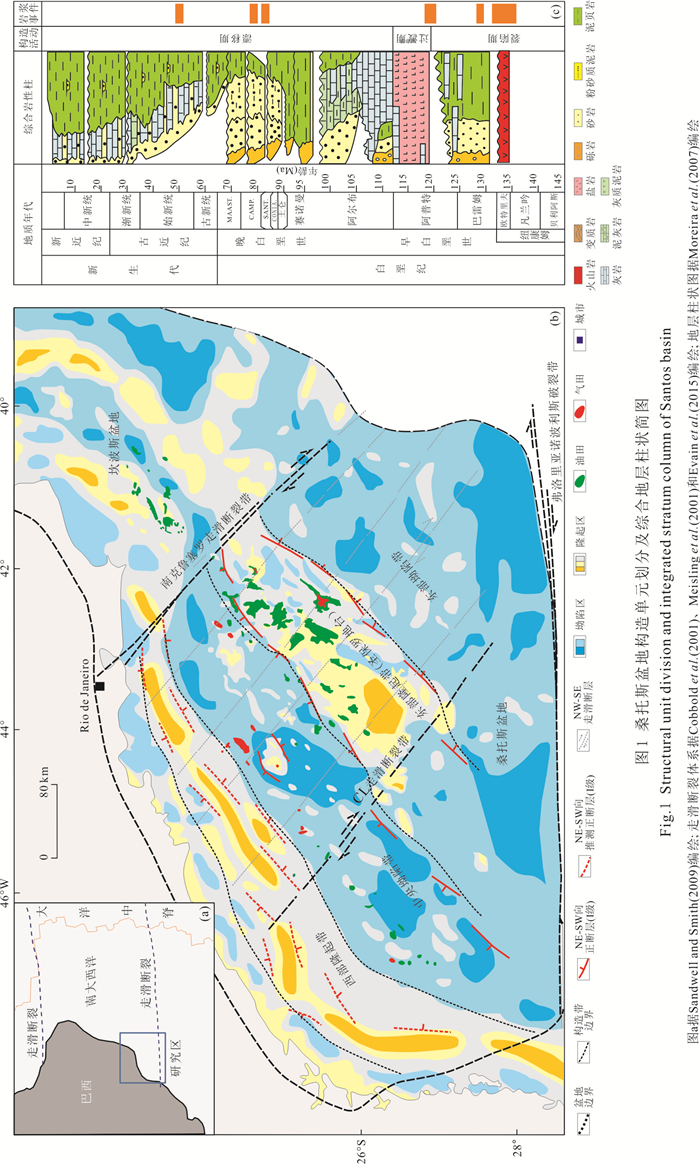
 下载:
下载:

